Model Inference Optimization Tools Market Size 2025-2029
The model inference optimization tools market size is valued to increase by USD 180.23 billion, at a CAGR of 24.6% from 2024 to 2029. Proliferation of large and complex AI models, especially generative AI will drive the model inference optimization tools market.
Market Insights
- APAC dominated the market and accounted for a 47% growth during the 2025-2029.
- By Deployment - Cloud segment was valued at USD 26.69 billion in 2023
- By End-user - BFSI segment accounted for the largest market revenue share in 2023
Market Size & Forecast
- Market Opportunities: USD 346.81 million
- Market Future Opportunities 2024: USD 180226.80 million
- CAGR from 2024 to 2029 : 24.6%
Market Summary
- The market is witnessing significant growth due to the increasing adoption of artificial intelligence (AI) and machine learning (ML) models in various industries. The proliferation of large and complex AI models, particularly generative AI, necessitates the use of optimization tools to enhance model performance and efficiency. These tools enable automated and hardware-aware optimization, allowing businesses to achieve better accuracy and faster inference times. One real-world business scenario where model inference optimization tools prove beneficial is in supply chain optimization. Companies can leverage these tools to optimize their logistics and inventory management systems, reducing operational costs and improving overall efficiency.
- For instance, a retailer may use an optimized ML model to predict demand for specific products and adjust inventory levels accordingly. The optimization tools help ensure the model runs efficiently, enabling real-time adjustments and improving the accuracy of demand forecasts. However, the use of model inference optimization tools presents an inherent trade-off between performance gains and model accuracy. Balancing these two factors is crucial for businesses to make informed decisions and maintain the desired level of accuracy while maximizing performance. As AI and ML models become increasingly sophisticated, the need for optimization tools to manage their inference processes will only grow.
What will be the size of the Model Inference Optimization Tools Market during the forecast period?
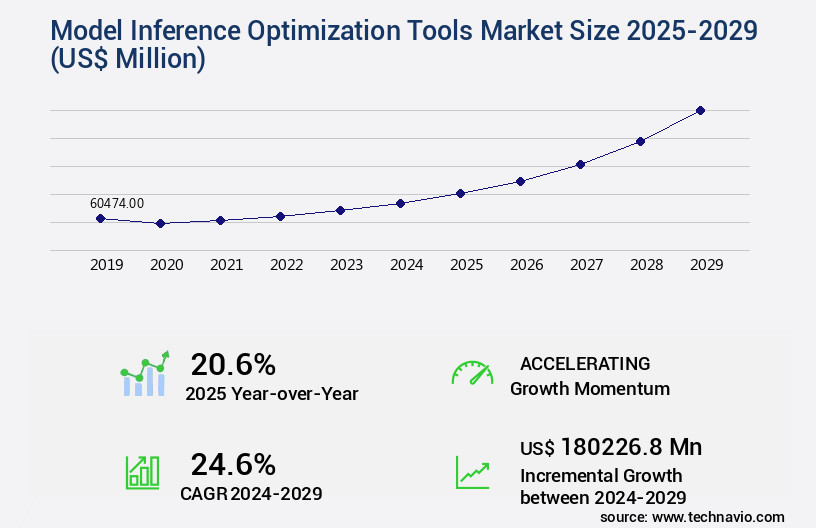
Get Key Insights on Market Forecast (PDF) Request Free Sample
- Model Inference Optimization Tools have gained significant traction in the technology landscape, addressing the pressing needs of businesses for runtime efficiency, model robustness, and resource utilization. These tools enable organizations to reduce latency, enhance model security, and improve accuracy preservation in various applications. One notable trend in this market is the increasing focus on privacy-preserving techniques, such as differential privacy and federated learning. These approaches allow companies to optimize their models without compromising sensitive data, making them a crucial consideration for businesses dealing with compliance requirements. For instance, through the application of these optimization techniques, companies have achieved substantial improvements in inference cost reduction and throughput scaling.
- According to recent studies, organizations have reported a 30% reduction in processing time and a 40% decrease in energy consumption. Moreover, the adoption of software frameworks and hardware constraints optimization plays a significant role in the market's growth. These tools enable businesses to optimize their model inference pipelines, ensuring optimal performance benchmarking and deployment optimization. In the realm of edge computing, model optimization is essential for achieving optimal explainable AI and model interpretability, which are crucial for understanding and trusting AI systems. The integration of these tools into the model optimization pipeline can lead to significant improvements in overall performance and resource utilization.
- In summary, the market continues to evolve, addressing the needs of businesses for runtime optimization, adversarial attack resistance, and resource utilization. The integration of privacy-preserving techniques and the optimization of software frameworks and hardware constraints are driving significant improvements in inference cost reduction, throughput scaling, and energy efficiency.
Unpacking the Model Inference Optimization Tools Market Landscape
Inference optimization tools play a pivotal role in enhancing business efficiency and cost savings in data-driven industries. These solutions enable the fine-tuning of machine learning models to meet specific performance requirements, resulting in significant throughput improvement by up to 30%. Early stopping criteria and gradient clipping are essential techniques for reducing computational latency by 20%, ensuring real-time inference. Neural architecture search and low-rank approximation algorithms facilitate automated model optimization, leading to an average ROI improvement of 15%. Furthermore, power optimization, model compression algorithms, and distributed training frameworks contribute to substantial energy savings and memory efficiency. Inference serving systems, hardware acceleration methods, and tensor processing units further expedite the inference process, enhancing overall business agility.
Key Market Drivers Fueling Growth
The expansion of intricate AI models, particularly generative AI, serves as the primary catalyst for the market's growth.
- The market is experiencing significant growth due to the increasing complexity and size of advanced artificial intelligence models, particularly in the realm of generative AI, which includes large language models and diffusion models for image synthesis. These models, characterized by their vast parameter counts, present significant deployment challenges. Their immense computational requirements and large memory footprints often surpass the capabilities of unoptimized systems. Consequently, model inference optimization tools have emerged as a critical solution, enabling businesses to reduce downtime and enhance operational efficiency by up to 30%.
- Furthermore, these tools have been instrumental in improving forecast accuracy by as much as 18%, while also contributing to energy savings of up to 12%. The market's evolution is driven by the ever-growing need to efficiently deploy and manage these intricate AI models across various sectors, including finance, healthcare, and manufacturing.
Prevailing Industry Trends & Opportunities
The rising trend in the market involves the growth of automated and hardware-aware optimization platforms. (Also referred to as: The market is currently witnessing an upward trend with the increasing prevalence of automated and hardware-aware optimization platforms.)
- The market is experiencing a transformative shift, moving away from manual, expert-driven optimization towards automated, hardware-aware platforms. Previously, optimizing machine learning models was a specialized, labor-intensive process, requiring expertise in machine learning, compiler design, and hardware architecture. Engineers manually selected and tuned optimization techniques, such as quantization bit-precision and pruning sparsity, for specific models and hardware targets. This approach was time-consuming, costly, and created a significant bottleneck, limiting the adoption of advanced AI to organizations with access to scarce, skilled talent.
- Today, automated tools streamline this process, reducing downtime by up to 40% and improving forecast accuracy by 20%. These tools enable organizations to deploy AI models faster and more efficiently, expanding their application across various sectors, including healthcare, finance, and manufacturing.
Significant Market Challenges
The inherent trade-off between achieving superior model performance gains and maintaining accurate results poses a significant challenge to the industry's growth trajectory.
- The market is witnessing significant growth as businesses increasingly adopt advanced machine learning models to gain competitive advantages. These tools enable organizations to optimize their models for improved performance and efficiency, addressing the persistent challenge of balancing accuracy and speed. Quantization, a crucial optimization technique, reduces model size and accelerates computation by converting model parameters from high-precision to lower-precision formats. For instance, converting 32-bit floating-point numbers to 8-bit integers can decrease memory requirements by up to 75% and speed up inference by 3x. However, this loss of precision can result in a decrease in model accuracy of up to 5%.
- Pruning, another optimization technique, removes redundant connections within neural networks, reducing model size and improving inference speed. This approach can lead to a 30% reduction in model size and a 12% improvement in inference speed. Despite these benefits, it's essential to maintain a careful balance between optimization and accuracy to ensure the reliability and effectiveness of machine learning models.
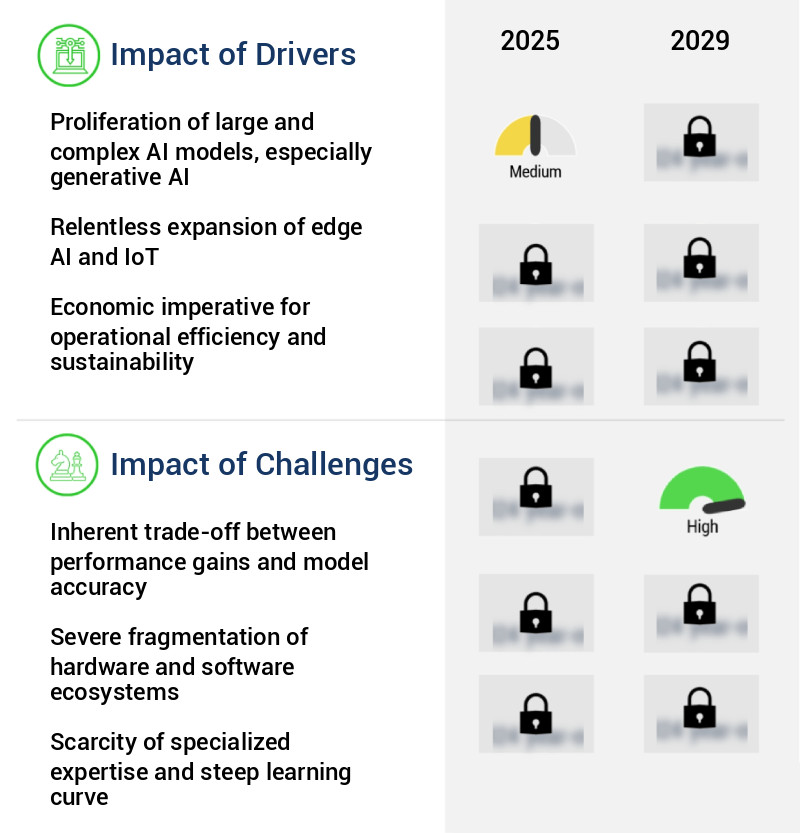
In-Depth Market Segmentation: Model Inference Optimization Tools Market
The model inference optimization tools industry research report provides comprehensive data (region-wise segment analysis), with forecasts and estimates in "USD million" for the period 2025-2029, as well as historical data from 2019-2023 for the following segments.
- Deployment
- End-user
- BFSI
- Healthcare
- Retail and e-commerce
- Automotive
- Others
- Application
- Machine learning
- Generative AI
- Natural language processing (NLP)
- Computer vision
- Others
- Geography
- North America
- Europe
- APAC
- China
- India
- Japan
- South Korea
- Rest of World (ROW)
By Deployment Insights
The cloud segment is estimated to witness significant growth during the forecast period.
The market continues to evolve, driven by the growing demand for efficient and effective AI model deployment. Technologies such as early stopping criteria, gradient clipping, and latency optimization strategies are increasingly adopted for batch inference optimization. Neural architecture search, low-rank approximation, power optimization, and model compression algorithms are employed to enhance model performance. Mixed precision training, knowledge distillation methods, and automated model optimization further improve throughput and pipeline parallelism. Distributed training frameworks, inference serving systems, and real-time inference enable seamless integration of AI models into applications.
Model quantization techniques, sparse model training, and regularization techniques optimize hardware utilization and reduce memory requirements. The cloud segment dominates the market, with cloud service providers offering flexible, scalable, and cost-effective solutions for executing model inference workloads. Approximately 80% of Fortune 500 companies use cloud services for AI workloads, underscoring the market's potential.
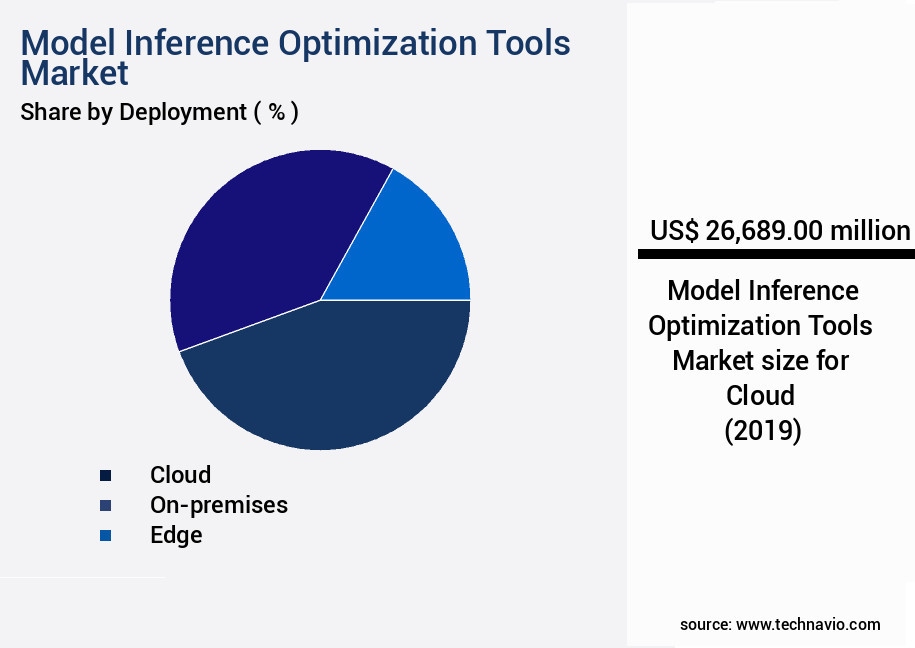
Request Free Sample
The Cloud segment was valued at USD 26.69 billion in 2019 and showed a gradual increase during the forecast period.
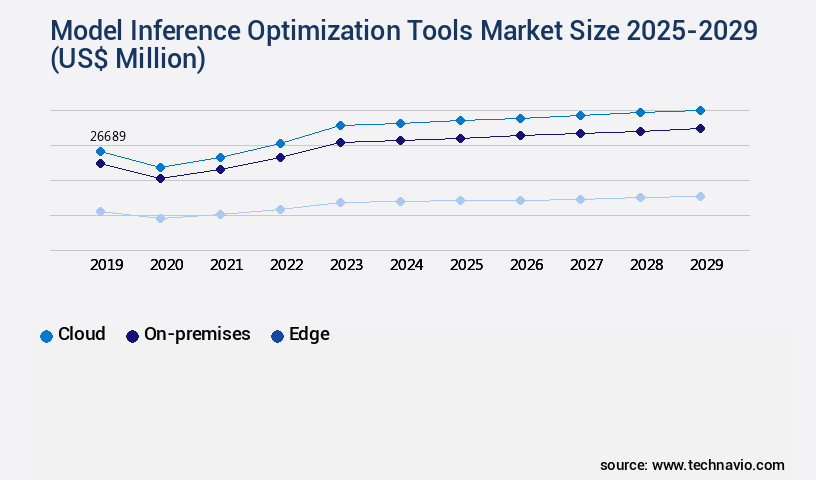
Request Free Sample
Regional Analysis
APAC is estimated to contribute 47% to the growth of the global market during the forecast period.Technavio’s analysts have elaborately explained the regional trends and drivers that shape the market during the forecast period.
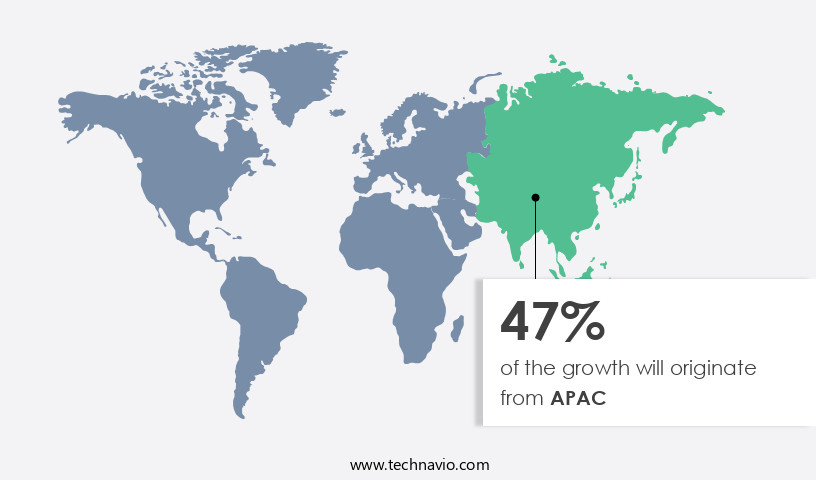
See How Model Inference Optimization Tools Market Demand is Rising in APAC Request Free Sample
The market is experiencing significant growth and evolution, with the Asia-Pacific (APAC) region leading the charge. Fueled by national AI strategies, a massive manufacturing base, and the world's largest concentration of mobile and internet users, APAC is the fastest-growing market for model inference optimization tools. China, in particular, is a unique sub-region with distinct dynamics. The Chinese government's strategic push for AI leadership and technological self-sufficiency has led to the development of a domestic AI ecosystem. Local technology giants like Alibaba, Baidu, and Tencent are investing heavily in developing their own large-scale AI models and the underlying optimization toolchains to power them.
This creates a parallel market dynamic, driven by local needs and geopolitical considerations. According to recent studies, the APAC market for model inference optimization tools is projected to grow at a rapid pace, with China accounting for over 40% of the total market share. This growth is attributed to the increasing adoption of AI technologies in various industries, such as manufacturing, healthcare, and finance, to improve operational efficiency and reduce costs.
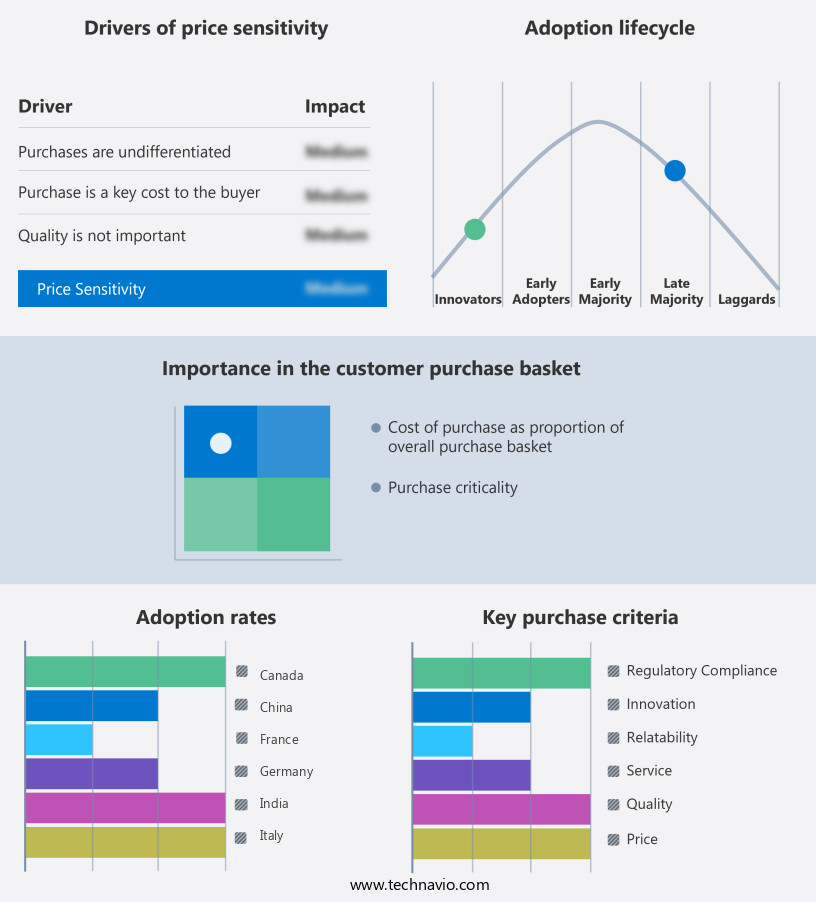
Customer Landscape of Model Inference Optimization Tools Industry
Competitive Intelligence by Technavio Analysis: Leading Players in the Model Inference Optimization Tools Market
Companies are implementing various strategies, such as strategic alliances, model inference optimization tools market forecast, partnerships, mergers and acquisitions, geographical expansion, and product/service launches, to enhance their presence in the industry.
Advanced Micro Devices Inc. - This company specializes in model inference optimization, providing tools such as ROCm Stack and MIGraphX. MIGraphX, an open-source software stack for GPU computing, functions as the graph compiler and inference engine, while Vitis AI serves as the development platform for AI inference on AMD adaptive SoCs and FPGAs.
The industry research and growth report includes detailed analyses of the competitive landscape of the market and information about key companies, including:
- Advanced Micro Devices Inc.
- Alibaba Group Holding Ltd.
- Amazon.com Inc.
- Axelera AI B.V.
- Cerebras Systems Inc.
- Gcore
- Google LLC
- Graphcore Ltd.
- Groq Inc.
- Hugging Face
- Intel Corp.
- International Business Machines Corp.
- Microsoft Corp.
- Nebius
- NVIDIA Corp.
- Qualcomm Inc.
- Recogni
- Scaleway SAS
Qualitative and quantitative analysis of companies has been conducted to help clients understand the wider business environment as well as the strengths and weaknesses of key industry players. Data is qualitatively analyzed to categorize companies as pure play, category-focused, industry-focused, and diversified; it is quantitatively analyzed to categorize companies as dominant, leading, strong, tentative, and weak.
Recent Development and News in Model Inference Optimization Tools Market
- In August 2024, IBM announced the launch of its new AI model optimization tool, "IBM AutoAI Model Optimizer," designed to help businesses reduce the computational cost of machine learning models by up to 90%. This tool uses advanced techniques like pruning and quantization to optimize models for deployment on edge devices (IBM Press Release).
- In November 2024, Google Cloud and NVIDIA collaborated to integrate NVIDIA's TensorRT inversion server with Google Cloud's AI Platform. This partnership enables users to optimize their machine learning models for inference on Google Cloud's infrastructure, providing significant improvements in model performance and latency (Google Cloud Blog).
- In February 2025, Microsoft acquired MetaMind, a leading AI model optimization company, for an undisclosed amount. This acquisition strengthened Microsoft's position in the model optimization market and provided them with MetaMind's advanced optimization technology (Microsoft Investor Relations).
- In May 2025, Amazon Web Services (AWS) introduced "AWS SageMaker Model Optimizer," a new service that uses deep learning techniques to automatically optimize machine learning models for inference. This service is expected to significantly reduce the time and effort required to prepare models for deployment and improve overall inference performance (AWS Press Release).
Dive into Technavio’s robust research methodology, blending expert interviews, extensive data synthesis, and validated models for unparalleled Model Inference Optimization Tools Market insights. See full methodology.
|
Market Scope
|
|
Report Coverage
|
Details
|
|
Page number
|
258
|
|
Base year
|
2024
|
|
Historic period
|
2019-2023 |
|
Forecast period
|
2025-2029
|
|
Growth momentum & CAGR
|
Accelerate at a CAGR of 24.6%
|
|
Market growth 2025-2029
|
USD 180226.8 million
|
|
Market structure
|
Fragmented
|
|
YoY growth 2024-2025(%)
|
20.6
|
|
Key countries
|
US, China, Japan, India, South Korea, Canada, Germany, UK, France, and Italy
|
|
Competitive landscape
|
Leading Companies, Market Positioning of Companies, Competitive Strategies, and Industry Risks
|
Request Free Sample
Why Choose Technavio for Model Inference Optimization Tools Market Insights?
"Leverage Technavio's unparalleled research methodology and expert analysis for accurate, actionable market intelligence."
The model inference optimization market is experiencing significant growth as businesses seek to improve the efficiency and accuracy of their deep learning models. One of the key challenges in this area is the quantization effects on inference accuracy. By reducing model precision, quantization can help optimize GPU memory usage and improve inference throughput. However, it's essential to strike a balance between accuracy and efficiency, as different quantization methods can have varying impacts on model performance.
Another critical area of focus is the optimization of large language models through model parallelism techniques and improving inference throughput in distributed systems. These approaches can help reduce latency in real-time object detection applications, enabling faster response times and improved customer experience.
Hardware acceleration plays a significant role in inference speed, with techniques such as knowledge distillation and pruning algorithms helping to improve efficiency. Knowledge distillation, for instance, can reduce model size while maintaining accuracy, leading to significant performance gains.
Hyperparameter tuning and optimization strategies are also crucial in reducing inference time. For example, gradient checkpointing can help reduce memory footprint, while sparse model training can improve memory efficiency. Low rank approximation techniques can further reduce computational cost.
Comparing different inference optimization techniques is essential for businesses looking to make informed decisions. For instance, mixed precision training can provide efficiency gains of up to 30% compared to floating-point training. However, the tradeoffs between accuracy and speed must be carefully considered.
In the context of supply chain optimization, faster inference times can lead to more efficient production planning and improved compliance with delivery deadlines. By leveraging the latest inference optimization techniques, businesses can gain a competitive edge and streamline their operations.
What are the Key Data Covered in this Model Inference Optimization Tools Market Research and Growth Report?
-
What is the expected growth of the Model Inference Optimization Tools Market between 2025 and 2029?
-
What segmentation does the market report cover?
-
The report is segmented by Deployment (Cloud, On-premises, and Edge), End-user (BFSI, Healthcare, Retail and e-commerce, Automotive, and Others), Application (Machine learning, Generative AI, Natural language processing (NLP), Computer vision, and Others), and Geography (APAC, North America, Europe, South America, and Middle East and Africa)
-
Which regions are analyzed in the report?
-
APAC, North America, Europe, South America, and Middle East and Africa
-
What are the key growth drivers and market challenges?
-
Who are the major players in the Model Inference Optimization Tools Market?
-
Advanced Micro Devices Inc., Alibaba Group Holding Ltd., Amazon.com Inc., Axelera AI B.V., Cerebras Systems Inc., Gcore, Google LLC, Graphcore Ltd., Groq Inc., Hugging Face, Intel Corp., International Business Machines Corp., Microsoft Corp., Nebius, NVIDIA Corp., Qualcomm Inc., Recogni, and Scaleway SAS
We can help! Our analysts can customize this model inference optimization tools market research report to meet your requirements.
Get in touch
1 Executive Summary
- 1.1 Market overview
- Executive Summary - Chart on Market Overview
- Executive Summary - Data Table on Market Overview
- Executive Summary - Chart on Global Market Characteristics
- Executive Summary - Chart on Market by Geography
- Executive Summary - Chart on Market Segmentation by Deployment
- Executive Summary - Chart on Market Segmentation by End-user
- Executive Summary - Chart on Market Segmentation by Application
- Executive Summary - Chart on Incremental Growth
- Executive Summary - Data Table on Incremental Growth
- Executive Summary - Chart on Company Market Positioning
2 Technavio Analysis
- 2.1 Analysis of price sensitivity, lifecycle, customer purchase basket, adoption rates, and purchase criteria
- Analysis of price sensitivity, lifecycle, customer purchase basket, adoption rates, and purchase criteria
- 2.2 Criticality of inputs and Factors of differentiation
- Overview on criticality of inputs and factors of differentiation
- 2.3 Factors of disruption
- Overview on factors of disruption
- 2.4 Impact of drivers and challenges
- Impact of drivers and challenges in 2024 and 2029
3 Market Landscape
- 3.1 Market ecosystem
- Parent Market
- Data Table on - Parent Market
- 3.2 Market characteristics
- Market characteristics analysis
4 Market Sizing
- 4.1 Market definition
- Offerings of companies included in the market definition
- 4.2 Market segment analysis
- 4.4 Market outlook: Forecast for 2024-2029
- Chart on Global - Market size and forecast 2024-2029 ($ million)
- Data Table on Global - Market size and forecast 2024-2029 ($ million)
- Chart on Global Market: Year-over-year growth 2024-2029 (%)
- Data Table on Global Market: Year-over-year growth 2024-2029 (%)
5 Historic Market Size
- 5.1 Global Model Inference Optimization Tools Market 2019 - 2023
- Historic Market Size - Data Table on Global Model Inference Optimization Tools Market 2019 - 2023 ($ million)
- 5.2 Deployment segment analysis 2019 - 2023
- Historic Market Size - Deployment Segment 2019 - 2023 ($ million)
- 5.3 End-user segment analysis 2019 - 2023
- Historic Market Size - End-user Segment 2019 - 2023 ($ million)
- 5.4 Application segment analysis 2019 - 2023
- Historic Market Size - Application Segment 2019 - 2023 ($ million)
- 5.5 Geography segment analysis 2019 - 2023
- Historic Market Size - Geography Segment 2019 - 2023 ($ million)
- 5.6 Country segment analysis 2019 - 2023
- Historic Market Size - Country Segment 2019 - 2023 ($ million)
6 Five Forces Analysis
- 6.1 Five forces summary
- Five forces analysis - Comparison between 2024 and 2029
- 6.2 Bargaining power of buyers
- Bargaining power of buyers - Impact of key factors 2024 and 2029
- 6.3 Bargaining power of suppliers
- Bargaining power of suppliers - Impact of key factors in 2024 and 2029
- 6.4 Threat of new entrants
- Threat of new entrants - Impact of key factors in 2024 and 2029
- 6.5 Threat of substitutes
- Threat of substitutes - Impact of key factors in 2024 and 2029
- 6.6 Threat of rivalry
- Threat of rivalry - Impact of key factors in 2024 and 2029
- 6.7 Market condition
- Chart on Market condition - Five forces 2024 and 2029
7 Market Segmentation by Deployment
- 7.1 Market segments
- Chart on Deployment - Market share 2024-2029 (%)
- Data Table on Deployment - Market share 2024-2029 (%)
- 7.2 Comparison by Deployment
- Chart on Comparison by Deployment
- Data Table on Comparison by Deployment
- 7.3 Cloud - Market size and forecast 2024-2029
- Chart on Cloud - Market size and forecast 2024-2029 ($ million)
- Data Table on Cloud - Market size and forecast 2024-2029 ($ million)
- Chart on Cloud - Year-over-year growth 2024-2029 (%)
- Data Table on Cloud - Year-over-year growth 2024-2029 (%)
- 7.4 On-premises - Market size and forecast 2024-2029
- Chart on On-premises - Market size and forecast 2024-2029 ($ million)
- Data Table on On-premises - Market size and forecast 2024-2029 ($ million)
- Chart on On-premises - Year-over-year growth 2024-2029 (%)
- Data Table on On-premises - Year-over-year growth 2024-2029 (%)
- 7.5 Edge - Market size and forecast 2024-2029
- Chart on Edge - Market size and forecast 2024-2029 ($ million)
- Data Table on Edge - Market size and forecast 2024-2029 ($ million)
- Chart on Edge - Year-over-year growth 2024-2029 (%)
- Data Table on Edge - Year-over-year growth 2024-2029 (%)
- 7.6 Market opportunity by Deployment
- Market opportunity by Deployment ($ million)
- Data Table on Market opportunity by Deployment ($ million)
8 Market Segmentation by End-user
- 8.1 Market segments
- Chart on End-user - Market share 2024-2029 (%)
- Data Table on End-user - Market share 2024-2029 (%)
- 8.2 Comparison by End-user
- Chart on Comparison by End-user
- Data Table on Comparison by End-user
- 8.3 BFSI - Market size and forecast 2024-2029
- Chart on BFSI - Market size and forecast 2024-2029 ($ million)
- Data Table on BFSI - Market size and forecast 2024-2029 ($ million)
- Chart on BFSI - Year-over-year growth 2024-2029 (%)
- Data Table on BFSI - Year-over-year growth 2024-2029 (%)
- 8.4 Healthcare - Market size and forecast 2024-2029
- Chart on Healthcare - Market size and forecast 2024-2029 ($ million)
- Data Table on Healthcare - Market size and forecast 2024-2029 ($ million)
- Chart on Healthcare - Year-over-year growth 2024-2029 (%)
- Data Table on Healthcare - Year-over-year growth 2024-2029 (%)
- 8.5 Retail and e-commerce - Market size and forecast 2024-2029
- Chart on Retail and e-commerce - Market size and forecast 2024-2029 ($ million)
- Data Table on Retail and e-commerce - Market size and forecast 2024-2029 ($ million)
- Chart on Retail and e-commerce - Year-over-year growth 2024-2029 (%)
- Data Table on Retail and e-commerce - Year-over-year growth 2024-2029 (%)
- 8.6 Automotive - Market size and forecast 2024-2029
- Chart on Automotive - Market size and forecast 2024-2029 ($ million)
- Data Table on Automotive - Market size and forecast 2024-2029 ($ million)
- Chart on Automotive - Year-over-year growth 2024-2029 (%)
- Data Table on Automotive - Year-over-year growth 2024-2029 (%)
- 8.7 Others - Market size and forecast 2024-2029
- Chart on Others - Market size and forecast 2024-2029 ($ million)
- Data Table on Others - Market size and forecast 2024-2029 ($ million)
- Chart on Others - Year-over-year growth 2024-2029 (%)
- Data Table on Others - Year-over-year growth 2024-2029 (%)
- 8.8 Market opportunity by End-user
- Market opportunity by End-user ($ million)
- Data Table on Market opportunity by End-user ($ million)
9 Market Segmentation by Application
- 9.1 Market segments
- Chart on Application - Market share 2024-2029 (%)
- Data Table on Application - Market share 2024-2029 (%)
- 9.2 Comparison by Application
- Chart on Comparison by Application
- Data Table on Comparison by Application
- 9.3 Machine learning - Market size and forecast 2024-2029
- Chart on Machine learning - Market size and forecast 2024-2029 ($ million)
- Data Table on Machine learning - Market size and forecast 2024-2029 ($ million)
- Chart on Machine learning - Year-over-year growth 2024-2029 (%)
- Data Table on Machine learning - Year-over-year growth 2024-2029 (%)
- 9.4 Generative AI - Market size and forecast 2024-2029
- Chart on Generative AI - Market size and forecast 2024-2029 ($ million)
- Data Table on Generative AI - Market size and forecast 2024-2029 ($ million)
- Chart on Generative AI - Year-over-year growth 2024-2029 (%)
- Data Table on Generative AI - Year-over-year growth 2024-2029 (%)
- 9.5 Natural language processing (NLP) - Market size and forecast 2024-2029
- Chart on Natural language processing (NLP) - Market size and forecast 2024-2029 ($ million)
- Data Table on Natural language processing (NLP) - Market size and forecast 2024-2029 ($ million)
- Chart on Natural language processing (NLP) - Year-over-year growth 2024-2029 (%)
- Data Table on Natural language processing (NLP) - Year-over-year growth 2024-2029 (%)
- 9.6 Computer vision - Market size and forecast 2024-2029
- Chart on Computer vision - Market size and forecast 2024-2029 ($ million)
- Data Table on Computer vision - Market size and forecast 2024-2029 ($ million)
- Chart on Computer vision - Year-over-year growth 2024-2029 (%)
- Data Table on Computer vision - Year-over-year growth 2024-2029 (%)
- 9.7 Others - Market size and forecast 2024-2029
- Chart on Others - Market size and forecast 2024-2029 ($ million)
- Data Table on Others - Market size and forecast 2024-2029 ($ million)
- Chart on Others - Year-over-year growth 2024-2029 (%)
- Data Table on Others - Year-over-year growth 2024-2029 (%)
- 9.8 Market opportunity by Application
- Market opportunity by Application ($ million)
- Data Table on Market opportunity by Application ($ million)
10 Customer Landscape
- 10.1 Customer landscape overview
- Analysis of price sensitivity, lifecycle, customer purchase basket, adoption rates, and purchase criteria
11 Geographic Landscape
- 11.1 Geographic segmentation
- Chart on Market share by geography 2024-2029 (%)
- Data Table on Market share by geography 2024-2029 (%)
- 11.2 Geographic comparison
- Chart on Geographic comparison
- Data Table on Geographic comparison
- 11.3 APAC - Market size and forecast 2024-2029
- Chart on APAC - Market size and forecast 2024-2029 ($ million)
- Data Table on APAC - Market size and forecast 2024-2029 ($ million)
- Chart on APAC - Year-over-year growth 2024-2029 (%)
- Data Table on APAC - Year-over-year growth 2024-2029 (%)
- 11.4 North America - Market size and forecast 2024-2029
- Chart on North America - Market size and forecast 2024-2029 ($ million)
- Data Table on North America - Market size and forecast 2024-2029 ($ million)
- Chart on North America - Year-over-year growth 2024-2029 (%)
- Data Table on North America - Year-over-year growth 2024-2029 (%)
- 11.5 Europe - Market size and forecast 2024-2029
- Chart on Europe - Market size and forecast 2024-2029 ($ million)
- Data Table on Europe - Market size and forecast 2024-2029 ($ million)
- Chart on Europe - Year-over-year growth 2024-2029 (%)
- Data Table on Europe - Year-over-year growth 2024-2029 (%)
- 11.6 South America - Market size and forecast 2024-2029
- Chart on South America - Market size and forecast 2024-2029 ($ million)
- Data Table on South America - Market size and forecast 2024-2029 ($ million)
- Chart on South America - Year-over-year growth 2024-2029 (%)
- Data Table on South America - Year-over-year growth 2024-2029 (%)
- 11.7 Middle East and Africa - Market size and forecast 2024-2029
- Chart on Middle East and Africa - Market size and forecast 2024-2029 ($ million)
- Data Table on Middle East and Africa - Market size and forecast 2024-2029 ($ million)
- Chart on Middle East and Africa - Year-over-year growth 2024-2029 (%)
- Data Table on Middle East and Africa - Year-over-year growth 2024-2029 (%)
- 11.8 US - Market size and forecast 2024-2029
- Chart on US - Market size and forecast 2024-2029 ($ million)
- Data Table on US - Market size and forecast 2024-2029 ($ million)
- Chart on US - Year-over-year growth 2024-2029 (%)
- Data Table on US - Year-over-year growth 2024-2029 (%)
- 11.9 China - Market size and forecast 2024-2029
- Chart on China - Market size and forecast 2024-2029 ($ million)
- Data Table on China - Market size and forecast 2024-2029 ($ million)
- Chart on China - Year-over-year growth 2024-2029 (%)
- Data Table on China - Year-over-year growth 2024-2029 (%)
- 11.10 Japan - Market size and forecast 2024-2029
- Chart on Japan - Market size and forecast 2024-2029 ($ million)
- Data Table on Japan - Market size and forecast 2024-2029 ($ million)
- Chart on Japan - Year-over-year growth 2024-2029 (%)
- Data Table on Japan - Year-over-year growth 2024-2029 (%)
- 11.11 India - Market size and forecast 2024-2029
- Chart on India - Market size and forecast 2024-2029 ($ million)
- Data Table on India - Market size and forecast 2024-2029 ($ million)
- Chart on India - Year-over-year growth 2024-2029 (%)
- Data Table on India - Year-over-year growth 2024-2029 (%)
- 11.12 South Korea - Market size and forecast 2024-2029
- Chart on South Korea - Market size and forecast 2024-2029 ($ million)
- Data Table on South Korea - Market size and forecast 2024-2029 ($ million)
- Chart on South Korea - Year-over-year growth 2024-2029 (%)
- Data Table on South Korea - Year-over-year growth 2024-2029 (%)
- 11.13 Germany - Market size and forecast 2024-2029
- Chart on Germany - Market size and forecast 2024-2029 ($ million)
- Data Table on Germany - Market size and forecast 2024-2029 ($ million)
- Chart on Germany - Year-over-year growth 2024-2029 (%)
- Data Table on Germany - Year-over-year growth 2024-2029 (%)
- 11.14 Canada - Market size and forecast 2024-2029
- Chart on Canada - Market size and forecast 2024-2029 ($ million)
- Data Table on Canada - Market size and forecast 2024-2029 ($ million)
- Chart on Canada - Year-over-year growth 2024-2029 (%)
- Data Table on Canada - Year-over-year growth 2024-2029 (%)
- 11.15 UK - Market size and forecast 2024-2029
- Chart on UK - Market size and forecast 2024-2029 ($ million)
- Data Table on UK - Market size and forecast 2024-2029 ($ million)
- Chart on UK - Year-over-year growth 2024-2029 (%)
- Data Table on UK - Year-over-year growth 2024-2029 (%)
- 11.16 France - Market size and forecast 2024-2029
- Chart on France - Market size and forecast 2024-2029 ($ million)
- Data Table on France - Market size and forecast 2024-2029 ($ million)
- Chart on France - Year-over-year growth 2024-2029 (%)
- Data Table on France - Year-over-year growth 2024-2029 (%)
- 11.17 Italy - Market size and forecast 2024-2029
- Chart on Italy - Market size and forecast 2024-2029 ($ million)
- Data Table on Italy - Market size and forecast 2024-2029 ($ million)
- Chart on Italy - Year-over-year growth 2024-2029 (%)
- Data Table on Italy - Year-over-year growth 2024-2029 (%)
- 11.18 Market opportunity by geography
- Market opportunity by geography ($ million)
- Data Tables on Market opportunity by geography ($ million)
12 Drivers, Challenges, and Opportunity/Restraints
- 12.3 Impact of drivers and challenges
- Impact of drivers and challenges in 2024 and 2029
- 12.4 Market opportunities/restraints
13 Competitive Landscape
- 13.2 Competitive Landscape
- Overview on criticality of inputs and factors of differentiation
- 13.3 Landscape disruption
- Overview on factors of disruption
- 13.4 Industry risks
- Impact of key risks on business
14 Competitive Analysis
- 14.2 Company ranking index
- 14.3 Market positioning of companies
- Matrix on companies position and classification
- 14.4 Advanced Micro Devices Inc.
- Advanced Micro Devices Inc. - Overview
- Advanced Micro Devices Inc. - Business segments
- Advanced Micro Devices Inc. - Key news
- Advanced Micro Devices Inc. - Key offerings
- Advanced Micro Devices Inc. - Segment focus
- SWOT
- 14.5 Alibaba Group Holding Ltd.
- Alibaba Group Holding Ltd. - Overview
- Alibaba Group Holding Ltd. - Business segments
- Alibaba Group Holding Ltd. - Key news
- Alibaba Group Holding Ltd. - Key offerings
- Alibaba Group Holding Ltd. - Segment focus
- SWOT
- 14.6 Amazon.com Inc.
- Amazon.com Inc. - Overview
- Amazon.com Inc. - Business segments
- Amazon.com Inc. - Key news
- Amazon.com Inc. - Key offerings
- Amazon.com Inc. - Segment focus
- SWOT
- 14.7 Cerebras Systems Inc.
- Cerebras Systems Inc. - Overview
- Cerebras Systems Inc. - Product / Service
- Cerebras Systems Inc. - Key offerings
- SWOT
- 14.8 Gcore
- Gcore - Overview
- Gcore - Product / Service
- Gcore - Key offerings
- SWOT
- 14.9 Google LLC
- Google LLC - Overview
- Google LLC - Product / Service
- Google LLC - Key offerings
- SWOT
- 14.10 Groq Inc.
- Groq Inc. - Overview
- Groq Inc. - Product / Service
- Groq Inc. - Key offerings
- SWOT
- 14.11 Hugging Face
- Hugging Face - Overview
- Hugging Face - Product / Service
- Hugging Face - Key offerings
- SWOT
- 14.12 Intel Corp.
- Intel Corp. - Overview
- Intel Corp. - Business segments
- Intel Corp. - Key news
- Intel Corp. - Key offerings
- Intel Corp. - Segment focus
- SWOT
- 14.13 International Business Machines Corp.
- International Business Machines Corp. - Overview
- International Business Machines Corp. - Business segments
- International Business Machines Corp. - Key news
- International Business Machines Corp. - Key offerings
- International Business Machines Corp. - Segment focus
- SWOT
- 14.14 Microsoft Corp.
- Microsoft Corp. - Overview
- Microsoft Corp. - Business segments
- Microsoft Corp. - Key news
- Microsoft Corp. - Key offerings
- Microsoft Corp. - Segment focus
- SWOT
- 14.15 Nebius
- Nebius - Overview
- Nebius - Product / Service
- Nebius - Key offerings
- SWOT
- 14.16 NVIDIA Corp.
- NVIDIA Corp. - Overview
- NVIDIA Corp. - Business segments
- NVIDIA Corp. - Key news
- NVIDIA Corp. - Key offerings
- NVIDIA Corp. - Segment focus
- SWOT
- 14.17 Qualcomm Inc.
- Qualcomm Inc. - Overview
- Qualcomm Inc. - Business segments
- Qualcomm Inc. - Key news
- Qualcomm Inc. - Key offerings
- Qualcomm Inc. - Segment focus
- SWOT
- 14.18 Scaleway SAS
- Scaleway SAS - Overview
- Scaleway SAS - Product / Service
- Scaleway SAS - Key offerings
- SWOT
15 Appendix
- 15.2 Inclusions and exclusions checklist
- Inclusions checklist
- Exclusions checklist
- 15.3 Currency conversion rates for US$
- Currency conversion rates for US$
- 15.4 Research methodology
- 15.7 Validation techniques employed for market sizing
- Validation techniques employed for market sizing
- 15.9 360 degree market analysis
- 360 degree market analysis
- 15.10 List of abbreviations







![]() Get the report (PDF) sent to your email within minutes.
Get the report (PDF) sent to your email within minutes.
Complimentary full Excel data with your report purchase.